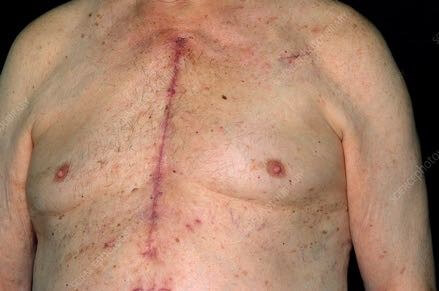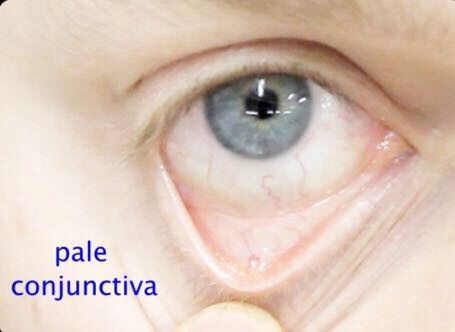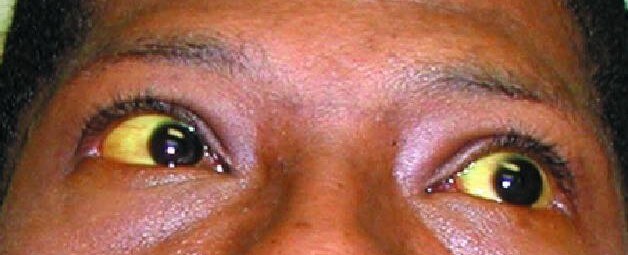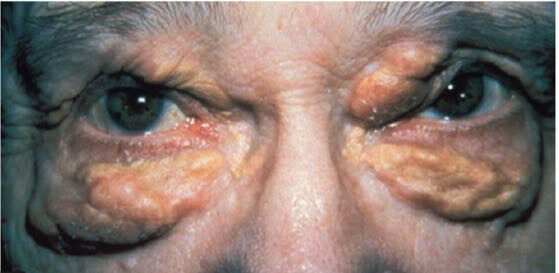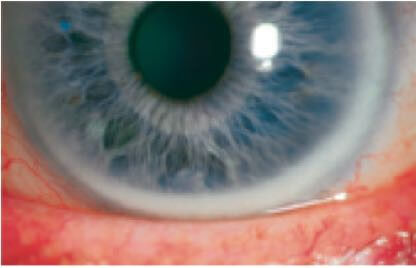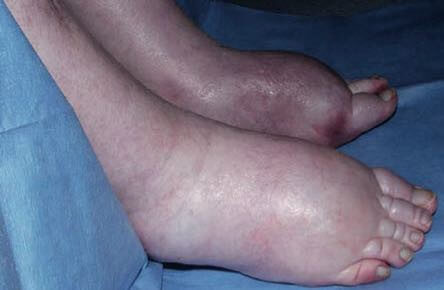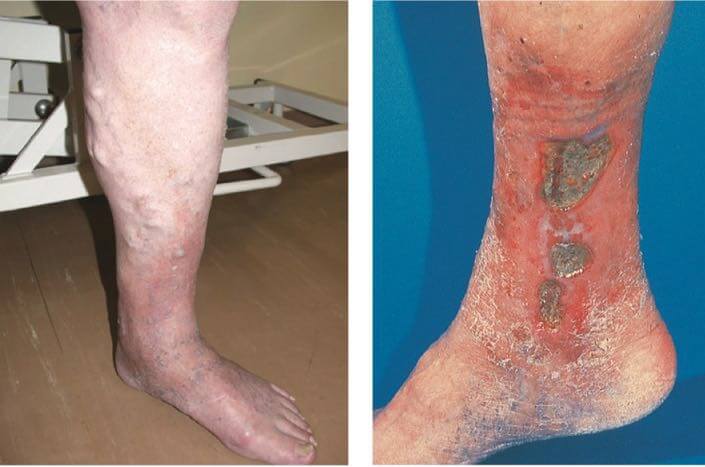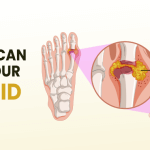Table of Contents
THE CARDIOVASCULAR EXAMINATION
Overview:
This in-depth article is tailored specifically for medical students, offering a comprehensive guide to mastering cardiovascular system examination. It provides detailed insights, step-by-step instructions, and valuable tips to help aspiring doctors hone their clinical skills.
Covering essential topics such as heart sounds, pulse assessment, and vein examination, this resource is designed to aid medical students in their studies and clinical practice. It also delves into interpreting examination findings, making it an indispensable reference for those pursuing a career in cardiology or general medicine.
With a focus on medical terminology and professional guidance, this article ensures that medical students are well-prepared for cardiovascular system examinations and equips them with the knowledge and expertise required for future clinical success.
THE FULL CARDIOVASCULAR SYSTEM EXAMINATION:
- Introduction + Consent + Wash Hands
- General Inspection:
- Body Habitus:
- Cardiac Cachexia (Portal Hypertension/RHF)
- Obesity (Diabetes/Dyslipidaemia/Poor Diet)
- Alert & Orientated?
- Dyspnoea/Respiratory Distress (CCF, Pulmonary Hypertension, Corpulmonale, MI)
- Discomfort/Pain (Angina, MI, Pericarditis, Tamponade)
- Diaphoresis (Angina, MI, Pain)
- Chest Deformities/Surgical Scars (CABG, Valve Repairs)
- Body Habitus:
■
- Congenital Facies (Marfan’s, Down’s, Turner’s Syndromes)


- Splinter Haemorrhages/Osler’s Nodes (Painful Fingertips)/Janeway Lesions (Palms Infec.Endo)

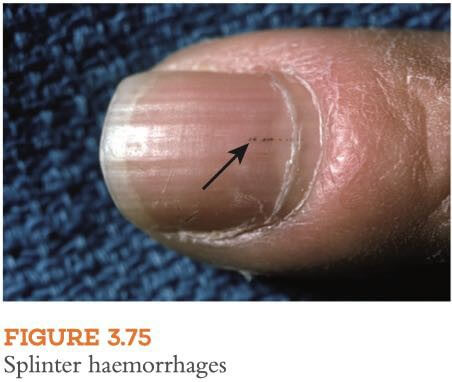
- Xanthomata (Cholesterol in tendons – Dyslipidaemia)
- Dupuytren’s Contracture (Alcohol – Dilated Cardiomyopathy)
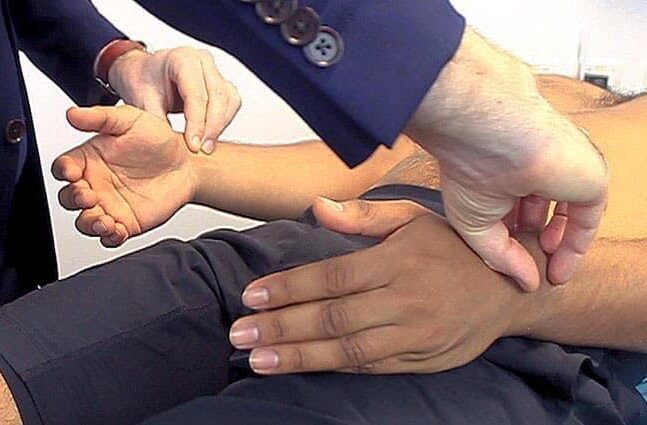

- Face:
- Eyes:
- Conjunctival Pallor (Anaemia)
- Eyes:
-
- Scleral Icterus (Jaundice)
-
- Xantholasma (periorbital cholesterol)
■ +Fundoscopy for Roth’s Spots (Infective Endocarditis)
-
- Arcus Senilis (Sign of CVD risk factors)
- Mitral Facies/Malar Rash (Mitral Stenosis)
- Mouth:
- Hydration
- Central Cyanosis/Peripheral Cyanosis (CCF – Pulmonary Oedema
- Gum Pallor (Anaemia)
- Poor Dental Hygeine (Infec.Endo)
- High Arched Palate (Marfan’s Syndrome)
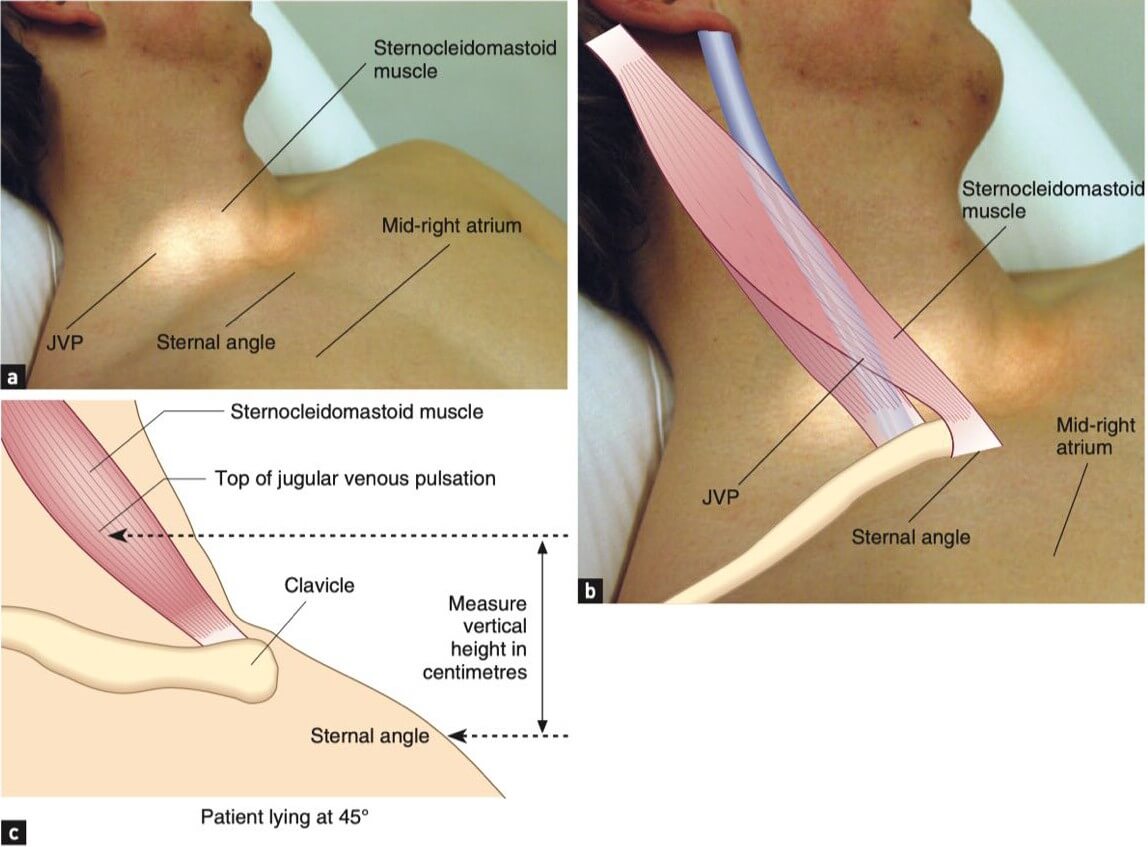
- Chest:
- Inspection:
- Scars (CABG, Sternotomy)
- Chest Deformities (Pectus Excavatum, Pectus Carinatum, Barrell Chest, Kyphosis, Lordosis)
- Bruising
- Visible Apex Beat
- Pacemaker
- Palpation:
- Apex Beat (Normally 5ICSMCL) – Displaced in Cardiomegaly & Hypertrophic Cardiomyopathy.
- Heaves (Mitral/Tricuspid Regurgitation)
- Thrills (Palpable Systolic Murmurs)
- Percussion (NOT NECESSARY):
- Heart Borders
- Auscultation:
- Muffled Heart Sounds (COPD, Tamponade)
- Murmurs (Mitral/Tricuspid/Aortic/Pulmonary Valves) (Bell – Diastolic)(Diaphragm – Systolic)
- +/- Axillary/Carotid Radiation
- Pericardial Friction Rub (Pericarditis)
- Inspection:
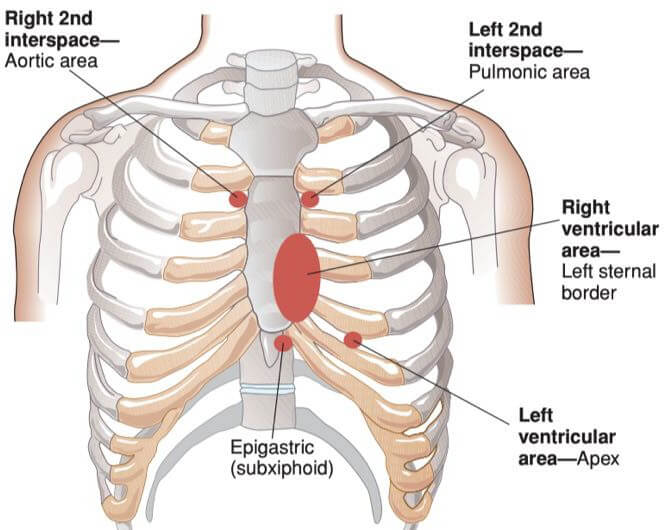
- Back:
- (+ Respiratory if CCF – Basal Inspiratory Crackles)
- Sacral Oedema (RHF)
- Abdomen – LYING FLAT:
- Visible Pulsatile Masses (Aneurysm)
- Scars
- Tenderness
- Hepatomegaly (Portal Hypertension/RHF)
- + Pulsatile (If Tricuspid Regurg)
- Splenomegaly (Infec.Endo)
- Ascites/Shifting Dullness/Fluid Thrill (RHF)
- Aortic Width (Aneurysm)
- Renal Bruits
■
- Venous Stasis (Shiny Skin, Hair Loss, & Venous Ulcers)
■
- Calf Tenderness (PVD, PE)
- Arterial Ulcers
- Pulses (Popliteal/Dorsalis Pedis/Posterior Tibial)
- Cap Refill/Warm/Well Perfused
- Clubbing
- Splinters/Janeways/Oslers
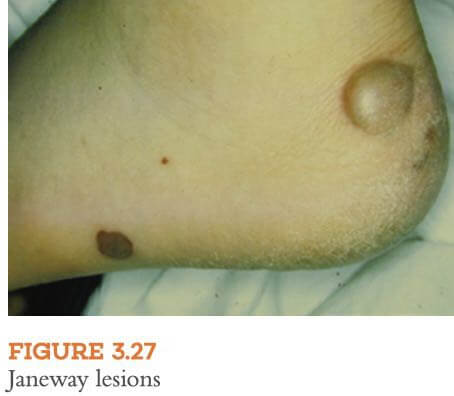
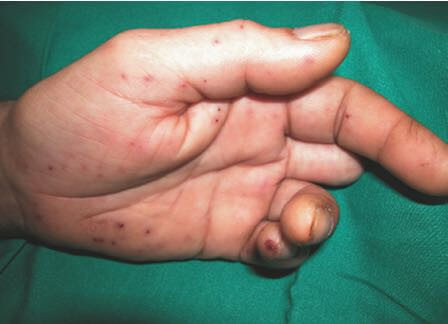
LIKELY FOCUSSED CARDIO EXAMS FOR OSCE
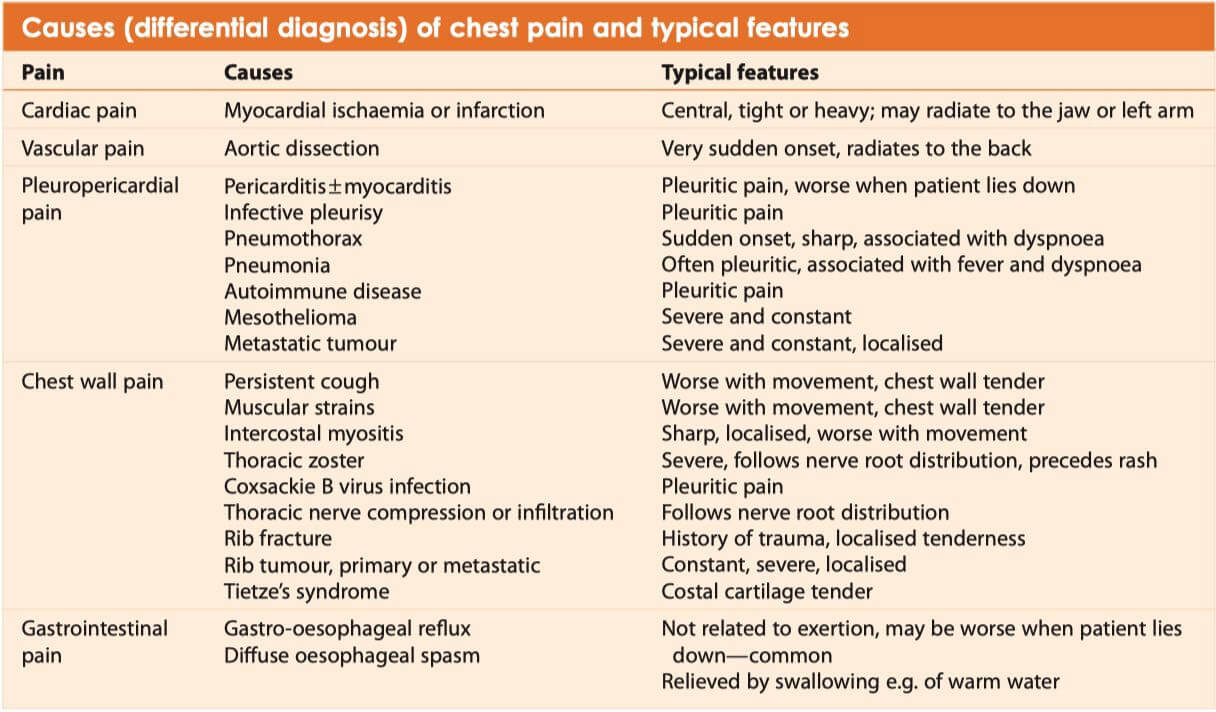

Cardiovascular Diseases and Clinical Co-relation:
Left Heart Failure (LVF):
- TYPICAL Symptoms/Presentation:
- Exertional Dyspnoea
- Orthopnea
- Paroxysmal Nocturnal Dyspnoea
- Wheezing Cough (“Cardiac Asthma”)
- (+ Syncope + Angina = Aortic Stenosis)
- (+ High Arch Palate of Marfans = Mitral Prolapse)
- TYPICAL Clinical Signs:
- Vitals:
- Tachypnoea, Tachycardia (Low Volume), Hypotension
- Other:
- ↓CO ➔ Cold peripheries, ↑CRT, Peripheral Cyanosis, Cerebral Hypoperfusion (Inattention, Confusion)
- Pulmonary Congestion ➔ Central Cyanosis, Basal Lung Crepitations, Diffuse Wheezes.
- Abdo-Jugular Reflux Positive.
- Laterally Displaced Apex Beat (LV Dilation)
- Signs of Causes:
- Mitral Facies & Mitral Regurg (Pan-Systolic Murmur over Mitral/Apex)
- Mitral Facies, Mitral Stenosis (Pan-Diastolic Crescendo Murmur over Mitral/Apex)
- OR Aortic Stenosis (Syst-Ejection Murmur over R.Sternal Border)
- OR Aortic Regurg (Decrescendo Diastolic Murmur over R.Sternal Border)
- (Cardiac Cachexia if ➔ Right Heart Failure)
- Vitals:
Right Heart Failure (RVF):
- TYPICAL Symptoms/Presentation:
- Anorexia/Cardiac Cachexia (Portal HTN)
- Swollen Ankles, Sacrum & Abdomen,
- Weight Gain (Fluid)
- (+ Pulsatile Liver = Tricuspid Regurg)
- TYPICAL Clinical Signs:
- Vitals:
- Low-Volume Pulse
- Other:
- ↓CO ➔ Cold peripheries, ↑CRT, Peripheral Cyanosis, Cerebral Hypoperfusion (Inattention, Confusion)
- RV-Heave
- Peripheral Congestion ➔ Peripheral Oedema (Sacral/Tibial), Ascites, Small Pleural Effusions.
- ↑JVP, Kussmaul’s Sign (↑JVP on Inspiration)
- Portal Hypertension ➔ “Cardiac Cachexia”, Caput Medusa, Tender Hepatomegaly, Pulsatile Liver (TR),
- Signs of Causes:
- COPD & Cor Pulmonale (RVF due to Pulmonary Hypertension)
- LVF (Pulmonary Congestion)
- Tricuspid Regurg (Pansystolic Murmur over Tricuspid + Pulsatile Liver)
- Vitals:
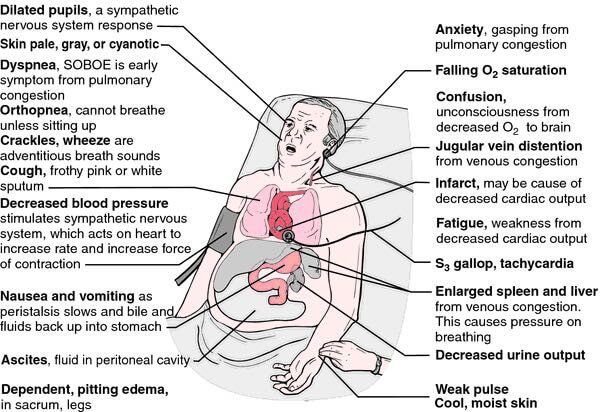
IHD & Acute Myocardial Infarction:
- TYPICAL Symptoms/Presentation:
- IHD:
- Angina (Severe Central Crushing Chest Pain):
- Stable = Transient Exertional
- Variant/Prinzmetal = Transient @ Rest
- Unstable = Resting Angina of ↑Severity & Frequency
- (+/- Diaphoresis, Dyspnoea, Anxiety)
- Angina (Severe Central Crushing Chest Pain):
- AMI:
- Angina (Severe Central Crushing Chest Pain)
- >20mins
- Radiating to L-Arm, Neck & Jaw
- Dyspnoea
- Diaphoresis
- Anxiety
- Angina (Severe Central Crushing Chest Pain)
- IHD:
- TYPICAL Clinical Signs:
- Vitals:
- Tachycardia/Bradycardia
- +/-Arrhythmias (AF, VT, VF, Heart Block)
- Tachycardia/Bradycardia
- Tachypnoea
- Hypotension
- Afebrile
- Vitals:
Pulmonary Embolism:
- TYPICAL Symptoms/Presentation:
- Sudden, SEVERE Dyspnoea
- Pleuritic Chest Pain
- (+/- Haemoptysis)
- (+/- Syncope)
- TYPICAL Clinical Signs:
- Vitals:
- Tachycardia, Tachypnoea, Hypotension (LVF), (+/-Fever)
- Other:
- RVF ➔ Cool Peripheries, ↑CRT, Peripheral Cyanosis, ↑JVP, RV-Heave, Tricuspid Regurg Murmur
- ↓Resp.Function ➔ Central Cyanosis
- Pleural Friction Rub,
- Signs of Causes:
- DVT – Calf Pain, Calf Tenderness, Calf Swelling/Erythema, Pedal Oedema.
- (B/G of Pregnancy, Air Travel, Recent Surgery, Clotting Disorders)
- DVT – Calf Pain, Calf Tenderness, Calf Swelling/Erythema, Pedal Oedema.
- Vitals:
Rheumatic Fever/ Rheumatic Heart Disease:
- TYPICAL Symptoms/Presentation:
- (Preceding Strep Throat):
- Fever, Pharyngitis, Tonsillitis, Lymphadenopathy
- Rheumatic Fever (>2wks Post GABH Strep Pharyngitis):
- Fever
- Joints – Migratory Polyarthritis, Ataxia
- Heart – Pleuritic Chest Pain (Fibrinous Pericarditis)
- Nodules – Subcut Nodules
- Erythema Marginatum – Red rings on trunk & limbs
- Sydenham Chorea – Rapid, Involuntary Mvts.
- (↑in Indigenous)
- Rheumatic Heart Disease:
- Palpitations (AF)
- LVF ➔ Exertional Dyspnoea, Orthopneoa, PND
- Mitral Facies
- (Preceding Strep Throat):
- TYPICAL Clinical Signs:
Acute Rheumatic Fever:
- Vitals:
- Fever, Tachycardia, Tachypnoea
- Other:
- Ataxia (due to polyarthritis)
- Pericardial Friction Rub (Fibrinous Pericarditis)
- Subcutaneous Nodules
- Erythema Marginatum (Red rings on trunk and limbs)
- Sydenham’s Chorea (Rapid, Involuntary, Purposeless Movements)
Rheumatic Heart Disease:
- Vitals:
- Afebrile, Tachycardia (+/- AF), Tachypnoea (CCF), Hypotensive
- Other:
- Mitral Facies & Mitral Stenosis (+/- Mitral Regurgitation)
- CCF ➔ Inspiratory Creps, Peripheral & Central Cyanosis, ↑JVP, Dyspnoea
- Signs of Cause:
- Indigenous, Low SES, Poor Hygiene

Acute Aortic Dissection:
- TYPICAL Symptoms/Presentation:
- Sudden, Severe Tearing Chest/Abdo Pain
- Radiating to Back
- (+/- Stroke)
- (+/- ALOC – due to Tamponade)
- (+/- Sudden Death)
- Sudden, Severe Tearing Chest/Abdo Pain
- TYPICAL Clinical Signs:
- Vitals:
- Unequal Radial Pulse Pressures,
- Asymmetrical Blood Pressure
- Other:
- Pulsatile, Expansile Abdominal Masses, Renal Bruits
- Signs of Tamponade (↑JVP, ↓Heart Sounds, Low-Volume Pulse, etc)
- Aortic Regurg (Due to disruption of annulus) (Decrescendo Diastolic Murmur)
- Signs of Causes:
- Marfan’s Habitus
- Complications:
- Myocardial Infarction (Coronary Occlusion), Mesenteric Ischaemia (Mesenteric Artery Occlusion), Pre-Renal Failure (Renal Artery Occlusion), Limb Ischaemia
- Vitals:
Infective Endocarditis:
- TYPICAL Symptoms/Presentation:
- Acute PUO – (+ Chills, Night-Sweats/Weight Loss)
- Dyspnoea
- Mild Arthralgia (“licks joints, bites the heart”)
- Palpitations
- Haematuria
- TYPICAL Clinical Signs:
- Vitals:
- Fever, Tachycardia, Tachypnoea
- Other:
- Clubbing, Palmar Crease Pallor, Splinter Haemorrhages (Septic Emboli), Janeway Lesions (Painless Maculopapular Bacterial Colonies on Palms), Painful Osler’s Nodes (Tender, Red, Raised Nodules on Pulps of Fingers)
- Trackmarks (IVDU),
- Conjunctival Pallor, Retinal Roth’s Spots (Retinal Haemorrhages), Poor Dentition,
- New or Changing Murmur (Either side of heart) (Often Tricuspid), Prosthetic Valve Click,
- Splenomegaly
- Signs of Causes:
- IVDU, Poor Dentition, Open Heart Surgery.
- Vitals:
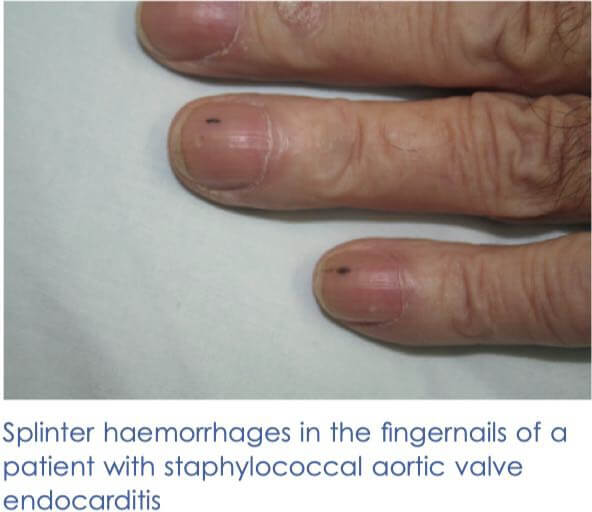
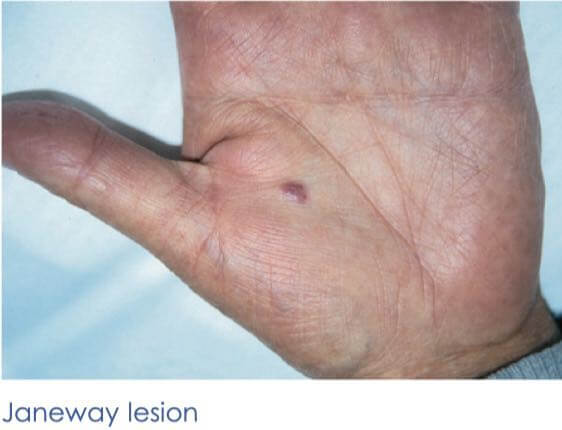
Acute Pericarditis:
- TYPICAL Symptoms/Presentation:
- Fever
- Dyspnoea (+/- Dry Cough)
- Pleuritic Chest Pain (Worse on Supine)
- TYPICAL Clinical Signs:
- Vitals:
- Tachycardia, Tachypnoea (Fast, Shallow), Febrile,
- Other:
- Pericardial Friction Rub (Best heard when sitting forward + hold breath)
- IF Tamponade ➔ ↑JVP, ↓Heart Sounds, Impalpable apex, & ↓CO.
- Signs of Causes:
- URTI, Post MI, Post Cardiac Surgery, Uraemia, SLE/Rheumatoid.
- Vitals:
Chronic Constrictive Pericarditis:
- TYPICAL Symptoms/Presentation:
- Acute Symptoms for >3mths
- Cachexia, Fatigue
- RVF ➔ Oedema, Abdo Distension
- TYPICAL Clinical Signs:
- Vitals:
- Tachycardia
- +*Pulsus Paradoxus (>10mmHg fall in Art.Pulse.Press. on Inspiration)
- Hypotension
- Other:
- Cachexia
- ↑JVP + Kussmaul’s Sign
- Impalpable Apex, ↓Heart Sounds, Pericardial ‘Knock’
- Tender Hepatomegaly, Tender Splenomegaly, Ascites & Periph. Oedema.
- Signs of Causes:
- Post MI, Post Cardiac Surgery, Uraemia, SLE/Rheumatoid
- Vitals:
Also Check out: All MBBS Books PDF 2023 FREE Download (First year to Final year)
Acute Cardiac Tamponade:
- TYPICAL Symptoms/Presentation:
- Dyspnoea
- Anxiety
- Syncope
- TYPICAL Clinical Signs:
- Vitals:
- Tachypnoea, Tachycardia (Low Volume & Pulsus Paradoxus), Hypotension, Afebrile
- Other:
- ↑JVP,
- Impalpable Apex, ↓Heart Sounds,
- Left Lung: Dull & Bronchial Breathing @ Base (Compressed by Heart)
- Vitals:
Acute Infective Myocarditis:
- TYPICAL Symptoms/Presentation:
- (Viral Infection (Flu, Coxsackie, CMV, HIV, Parvo))
- Acute Heart Failure– Dyspnoea/Orthopnoea, ALOC, Cardiogenic Shock.
- Palpitations
- Sudden Death
- TYPICAL Clinical Signs:
- Vitals:
- Febrile, Tachycardia, Tachypnoea, Hypotension (if HF)
- Other:
- Acute Heart Failure – Peripheral Shutdown, ↑CRT, Low Pulse Pressure, ALOC, ↑JVP, Pulmonary Congestion, Dyspnoea, Basal Creps.
- Palpitations
- Signs of Causes:
- URTI, Immunocompromise (HIV).
- Vitals:
Acute Toxic Myocarditis:
- TYPICAL Symptoms/Presentation:
- (Cocaine, Prescription Meds, Arsenic, Alcohol, Snake Venom, Carbon Monoxide)
- Acute Heart Failure– Dyspnoea/Orthopnoea, ALOC, Cardiogenic Shock.
- Palpitations
- Sudden Death
- TYPICAL Clinical Signs:
- Vitals:
- Afebrile, Tachycardia, Tachypnoea, Hypotension (if HF)
- Other:
- Acute Heart Failure – Peripheral Shutdown, ↑CRT, Low Pulse Pressure, ALOC, ↑JVP, Pulmonary Congestion, Dyspnoea, Basal Creps.
- Palpitations
- CO-Poisoning ➔ Headache, Dizziness, Nausea, Convulsions, ALOC
- Signs of Causes:
- Nasal Septal Necrosis (Cocaine), Snake Bite Marks, Confusion/Ataxia/Delirium.
- Vitals:
Dilated Cardiomyopathy: (Alcoholism/Genetic)
- TYPICAL Symptoms/Presentation:
- Any Age
- Biventricular Heart Failure – Dyspnoea, Orthopnoea, PND, Fatigue, Cyanosis, Peripheral Oedema, Ascites, Fatigue, Anorexia.
- +/- Palpitations
- TYPICAL Clinical Signs:
- Vitals:
- Tachycardia (+/- Ventricular Arrhythmias), Tachypnoea, Hypotension, Afebrile
- Other:
- Cool Peripheries, ↑CRT, Peripheral & Central Cyanosis, Low-Volume Pulse,
- Dyspnoea, Orthopnoea, PND,
- Peripheral Oedema, Ascites, Tender Hepatomegaly, Pulsatile Liver(TR),
- ↓Heart Sounds, Basal Inspiratory Creps,
- Signs of Causes:
- Dupuytren’s Contractures (Chronic Alcoholism)
- Vitals:
Hypertrophic Cardiomyopathy: (Genetic)
- TYPICAL Symptoms/Presentation:
- Ex.Dyspnoea (LVF ➔Pulmonary Congestion)
- Angina (↑Demand on Coronary Supply)
- Palpitations (AF/V.Arrhythmias)
- Syncope
- TYPICAL Clinical Signs:
- Vitals:
- Tachycardia, Tachypnoea, Hypotension, Afebrile
- Other:
- Cool Peripheries, ↑CRT, Peripheral & Central Cyanosis,
- Sharp “Tapping” Pulse, Low Volume Pulse,
- Prominent Pulsatile JVP (↓RV-Compliance)
- Lateral Apex Displacement, Ejection Systolic Murmur (LV-Outflow Obstruction – ↑on Valsalva & ↓on Squatting) & Pansystolic Murmur (Mitral Regurg)
- Vitals:
Restrictive Cardiomyopathy: (Amyloid/Sarcoid-osis)
- TYPICAL Symptoms/Presentation:
- Cachexia/Fatigue
- RVF ➔ Oedema, Abdo Distension, ↑JVP
- LVF – Cough/Dyspnoea/PND/Orthopnea
- Palpitations
- TYPICAL Clinical Signs:
- Vitals:
- Tachycardia (+/- Arrhythmias), Low-Volume Pulse,
- Hypotension
- +*Pulsus Paradoxus (>10mmHg fall in Art.Pulse.Press. on Inspiration)
- Other:
- Cool Peripheries, ↑CRT, Peripheral & Central Cyanosis,
- Cachexia
- ↑JVP + Kussmaul’s Sign
- Impalpable Apex, ↓Heart Sounds,
- Tender Hepatomegaly, Tender Splenomegaly, Ascites & Periph. Oedema.
- Signs of Causes:
- Post MI, Post Cardiac Surgery, Uraemia, SLE/Rheumatoid
- Vitals:
Stress Cardiomyopathy: (Broken Heart Syndrome/Takotsubo)
- TYPICAL Symptoms/Presentation:
- Sudden Onset CCF:
- Chest Pain
- Dyspnoea
- Palpitations (Vent. Arrhythmias)
- Sudden Onset CCF:
- TYPICAL Clinical Signs:
- Vitals:
- Tachycardia (+/- Arrhythmias), Low-Volume Pulse,
- Hypotension
- Other:
- Cool Peripheries, ↑CRT, Peripheral & Central Cyanosis,
- Vitals:
Systemic Hypertension:
- TYPICAL Symptoms/Presentation:
- Headaches/Dizziness
- Blurred Vision/Tinnitis
- Hypertensive Encephalopathy (N/V/ALOC)
- (Epistaxis)
- TYPICAL Clinical Signs:
- Inspect for Signs of Causes:
- Cushing’s Syndrome, Conn’s Syndrome, ↑PTH, Hypercalcaemia, Hyperthyroidism, Hypothyroidism, Pregnancy (Eclampsia), Acromegaly, Polycythaemia, CKD, Phaeo,
- Vitals:
- Hypertension (NB: Inverse Postural Variation in Essential Hypertenison, but Normal Postural Variation in Secondary Hypertension),
- RF-Delay (coarctation)
- Other:
- Palmar Erythema, ↓CRT, Facial Flushing
- Fundoscopy (Hypertensive Retinopathy +/- Papilloedema), Full Neurological Exam
- Carotid Palpation, Carotid Bruits
- S4 on Auscultation (4th Heart Sound = Splitting of S1 due to late Mitral Closure)
- Pulsatile Abdominal Masses (Aneurysm), Renal Masses (Tumours), Renal Bruits,
- +Urinalysis
- Inspect for Signs of Causes:
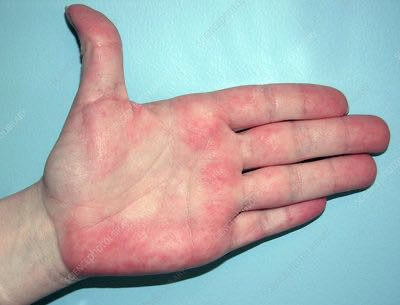

Pulmonary Hypertension & Corpulmonale: (LVF, COPD)
- TYPICAL Symptoms/Presentation:
- RVF Secondary to Pulmonary Hypertension:
- COPD: Dyspnoea, Cough, Wheeze
- Pul HTN: Cough/Dyspnoea/PND/Orthopnea
- RVF: Swelling (Legs, Abdo), Chest Pain
- RVF Secondary to Pulmonary Hypertension:
- TYPICAL Clinical Signs:
- Vitals:
- Tachycardia (if LVF), Tachypnoea (if COPD/LVF), Hypotension (If LVF), Afebrile
- Other:
- If LVF: Cool Peripheries, ↑CRT, Peripheral & Central Cyanosis, Low Volume Pulse
- If COPD: Clubbing, Tar Staining, Peripheral & Central Cyanosis
- ↑JVP + a-Wave, RV-Heave, Loud S2 (closure of Pul.Valve) Abdojugular Reflux Positive, Portal Hypertension (Tender Hepatomegaly), Ascites, Sacral/Pedal Oedema,
- Signs of Causes:
- LVF, Smoking, COPD, IPF
- Vitals:
Carcinoid Heart Disease:
- TYPICAL Symptoms/Presentation:
- Episodic Flushing of Skin
- Cramps
- Diarrhoea/Nausea/Vomiting
- (+/- Valvular Heart Failure)
- (+/- Bronchoconstriction ➔ Dyspnoea)
- TYPICAL Clinical Signs:
- Flushing of Skin
- RVF: Tricuspid Regurg (Pansystolic Murmurs), Pulmonary Stenosis (Systolic Murm), Tender Hepatomegaly, Portal Hypertension
Mitral Stenosis:
- TYPICAL Symptoms/Presentation:
- LVF – Exertional Dyspnoea/Orthopnea/PND/ Pink Frothy Sputum
- (If RVF ➔ Ascites/Periph.Oedema/Fatigue)
- TYPICAL Clinical Signs:
- Vitals:
- Tachycardia (Low-Vol Pulse, +/- AF), Tachypnoea, Hypotensive
- Other:
- LVF: Cool Peripheries, ↑CRT, Peripheral & Central Cyanosis, Low Volume Pulse,
- Mitral Facies, ↑JVP if Pulmonary HTN, RV-Heave, Inspiratory Creps,
- Mitral Stenosis (Pan-Diastolic Rumbling Murmur with Opening Snap & late Cresc)
- Signs of Causes:
- Rheumatic Heart Disease, Congenital
- Vitals:
Mitral Regurgitation:
- TYPICAL Symptoms/Presentation:
- Acute (Eg. Papillary Rupture, MI, Infec.Endo):
- Acute Pulmonary Oedema ➔ Exertional Dyspnoea/Orthopnea/PND/ Pink Frothy Sputum
- +/- Shock
- Acute (Eg. Papillary Rupture, MI, Infec.Endo):
- Chronic (Eg. MVP, Ageing, RhHD, Cardiomyopathy) :
- Compensated Pulmonary Oedema ➔ Exertional Dyspnoea/Fatigue
Acute:
- Vitals:
- Tachycardia (Low Vol. +/- AF), Tachypnoea, Hypotension
- Other:
- LVF: Cool Peripheries, ↑CRT, Peripheral & Central Cyanosis, Low Volume Pulse,
- Mitral Facies, ↑JVP if Pulmonary HTN, RV-Heave, Inspiratory Creps,
- Mitral Regurgitation (Loud Systolic Murmur + Thrill @ Apex)
- Signs of Causes:
- Papillary Rupture, MI, Infec.Endo
Chronic:
- Vitals:
- Normal Pulse Rate & Volume (+/- AF), Tachypnoea, Normotensive
- Other:
- Displaced Apex, RV-Heave, Mitral Regurgitation (Loud Systolic Murmur ➔Axilla + Thrill @ Apex)
- If Severe: Signs of LVF (Cool Periph, ↑CRT, P&C-Cyanosis, Low Volume Pulse)
- Signs of Causes:
- MVP, Ageing, RhHD, Cardiomyopathy
Aortic Stenosis:
- TYPICAL Symptoms/Presentation:
- Aortic Stenosis Triad:
- Exertional Chest Pain
- Exertional Dyspnoea
- Exertional Syncope
- Aortic Stenosis Triad:
- TYPICAL Clinical Signs:
- Vitals:
- Normal/Tachycardia
- Other:
- General Inspection Normal
- Slow-Rising (“Anacrotic”) Carotid Pulse, Displaced Apex (LV-Hypertrophy),
- Systolic R-Parasternal Thrill (if Severe)
- Reversed Splitting of S2 (Delayed LV Ejection), Harsh Cresc-Decres Systolic Murmur Over Aorta + Opening Snap (Radiating to Carotids)
- Signs of Causes:
- Age-Related (Elderly), Rheumatic
- Vitals:
Aortic Insufficiency:
- TYPICAL Symptoms/Presentation:
- Same as Aortic Stenosis:
- Exertional Chest Pain
- Exertional Dyspnoea
- Exertional Syncope
- Same as Aortic Stenosis:
- TYPICAL Clinical Signs:
- Vitals:
- Tachycardia, BP: Wide Pulse Pressure, R: Normal
- Other:
- Inspect for Marfan’s
- Collapsing “Water-Hammer” Pulse (↑by Taking Radial Pulse Above Pt’s Head),
- Displaced Apex (LV Hypertrophy), Diastolic Thrill @ L-Sternal,
- Decrescendo Diastolic Murmur @ Aortic Area
- (Signs of LVF if Severe)
- Signs of Causes:
- Marfan’s Syndrome
- Ankylosing Spondylitis,
- Rheumatoid Arthritis,
- Tertiary Syphilis,
- Infective Endo.
- Vitals:
Tricuspid Stenosis (Rare):
- TYPICAL Symptoms/Presentation:
- RHF – Peripheral Oedema/Ascites/Portal Hypertension
- TYPICAL Clinical Signs:
- Vitals:
- Tachycardia
- Other:
- ↑JVP with Slow Descent, No Pulmonary Signs
- Pan-Diastolic Rumbling Tricuspid Murmur + Late Accentuation (Atrial Contraction)
- Tender Pulsatile Hepatomegaly, Splenomegaly, Ascites, Peripheral Oedema
- Signs of Causes:
- Rheumatic Heart Disease
- Vitals:
Tricuspid Insufficiency:
- TYPICAL Symptoms/Presentation:
- RHF – Peripheral Oedema/Ascites/Portal Hypertension
- TYPICAL Clinical Signs:
- Vitals:
- Tachycardia
- Other:
- ↑JVP with Large Pulsations, RV Heave,
- Pan-Systolic High-Pitched Tricuspid Murmur
- Tender Pulsatile Hepatomegaly (+/- Dancing R-Nipple), Splenomegaly, Ascites, Peripheral Oedema, Pulsatile Leg Veins.
- Signs of Causes:
- ***IVDU, Infective Endocarditis.
- Vitals:

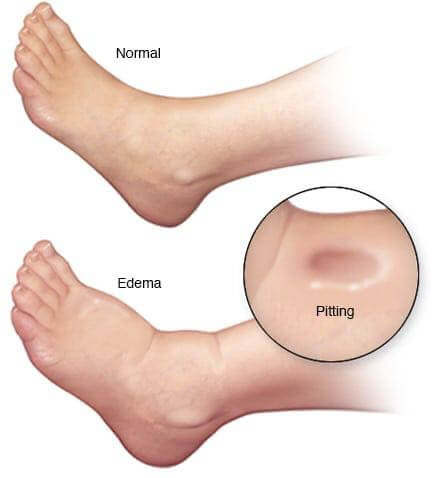
Pulmonary Stenosis:
- TYPICAL Symptoms/Presentation:
- RHF – Peripheral Oedema/Ascites
- Chest Pain
- Dyspnoea
- TYPICAL Clinical Signs:
- Vitals:
- Tachycardia, Low Volume Pulse (If Severe), Hypotension (if Severe)
- Other:
- (↓CO) ➔Peripheral Cyanosis, Cool Peripheries, ↑CRT, Low Volume Pulse
- ↑JVP with Large Pulsations (RA-Hypertrophy), RV Heave (RV-Hypertrophy), Pulmonary Thrill,
- Ejection Systolic Murmur @ Pulmonary Area (Max on Inspiration)
- Pulsatile Tender Hepatomegaly
- Signs of Causes:
- Congenital, Carcinoid.
- Vitals:
Pulmonary Insufficiency:
- TYPICAL Symptoms/Presentation:
- RHF – Peripheral Oedema/Ascites
- Chest Pain
- Dyspnoea
- TYPICAL Clinical Signs:
- Vitals:
- Tachycardia, Low Volume Pulse (If Severe), Hypotension (if Severe)
- Other:
- ↓CO, ↑JVP, Decrescendo Diastolic Pulmonary Murmur
- Signs of Causes:
- Pul HTN, Infec.Endo, Congenital
- Vitals:
Pulmonary Hypertension & Corpulmonale: (LVF, COPD)
- TYPICAL Symptoms/Presentation:
- RVF Secondary to Pulmonary Hypertension:
- COPD: Dyspnoea, Cough, Wheeze
- Pul HTN: Cough/Dyspnoea/PND/Orthopnea
- RVF: Swelling (Legs, Abdo), Chest Pain
- RVF Secondary to Pulmonary Hypertension:
- TYPICAL Clinical Signs:
- Vitals:
- Tachycardia (if LVF), Tachypnoea (if COPD/LVF), Hypotension (If LVF), Afebrile
- Other:
- If LVF: Cool Peripheries, ↑CRT, Peripheral & Central Cyanosis, Low Volume Pulse
- If COPD: Clubbing, Tar Staining, Peripheral & Central Cyanosis
- ↑JVP + a-Wave, RV-Heave, Loud S2 (closure of Pul.Valve) Abdojugular Reflux Positive, Portal Hypertension (Tender Hepatomegaly), Ascites, Sacral/Pedal Oedema,
- Signs of Causes:
- LVF, Smoking, COPD, IPF
- Vitals:
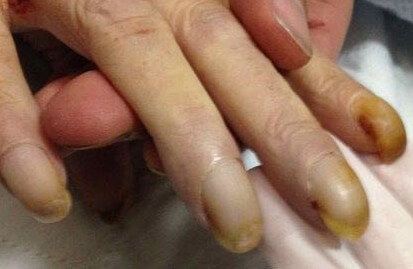
Atrial Septal Defect (L-R):
- TYPICAL Symptoms/Presentation:
- Asymptomatic until ≈30yrs.
- Eventual RVF (Periph. Oedema/Ascites) due to Pulmonary HTN (Dyspnoea/Orthop/PND)
- TYPICAL Clinical Signs:
- Vitals:
- Normal
- Other:
- RV-Hypertrophy, Fixed Splitting of S2 (Late Tricuspid Closure)
- (If Shunt Reverses ➔ Cyanosis, Clubbing, Tachycardia, Tachypnoea)
- Vitals:
Ventricular Septal Defect (L-R):
- TYPICAL Symptoms/Presentation:
- **(Infants) Failure to Thrive
- LVF & Pulm HTN (Dyspnoea/Orthop/PND)
- TYPICAL Clinical Signs:
- Vitals:
- Tachycardia, Tachypnoea, Hypotension,
- Other:
- Signs of ↓CO
- Pansystolic Murmur @ Lower L-Sternal border, + Systolic Thrill @ L-Steral Edge
- Signs of Causes:
- Congenital, (Or Septal MI)
- Vitals:
Patent Ductus Arteriosus (Aorta ➔Pul.Artery):
- TYPICAL Symptoms/Presentation:
- Pul.HTN ➔ Pul.Congestion/Dyspnoea/Cough
- TYPICAL Clinical Signs:
- Vitals:
- Tachycardia (Collapsing Pulse), Hypotension (with ↓Diastolic)
- Other:
- Hyperkinetic Apex Beat, Reversed Splitting of S2 (Early Aortic.V Closure)
- “machinery Murmur” max @ Pulmonary
- **NB: IF THE SHUNT HAS REVERSED, the Child may become Dyspnoeic/Cyanotic which is relieved by Squatting (which ↑Aortic Pressure & Reverts shunt back to L➔R)
- Vitals:
Coarctation of Aorta: (Typically distal to L-Subclavian)
- TYPICAL Symptoms/Presentation:
- Poor Lower-Body Development
- Claudication
- TYPICAL Clinical Signs:
- Vitals:
- Upper-Body HTN, Lower Body Hypotension,
- Other:
- Radio-Femoral Delay, Weak Femoral Pulses, Midsystolic Murmor @ Praecordium
- Signs of Causes:
- Congenital, Mostly Males (Although also assoc’d with Turner’s Syndrome)
- Vitals:
Tetralogy of Fallot: (VSD + RVH + Overriding Aorta + Subpulmonic Stenosis)
- TYPICAL Symptoms/Presentation:
- (Infants) – Poor Feeding, Cyanotic Spells, Failure to Thrive, Syncope
- TYPICAL Clinical Signs:
- Vitals:
- Tachycardia, Tachypnoea, Hypotension
- Other:
- Central & Peripheral Cyanosis (Blue Baby), Clubbing, Polycythaemia, Parasternal Heave (RVH), Systolic Thrill, Pulmonary Ejection Systolic Murmur.
- Vitals:
Transposition of Great Vessels:
- TYPICAL Symptoms/Presentation:
- (Fatal Without Concurrent ASD/VSD Exists)
- With ASD/VSD:
- Cyanosis, Palpitations, Dizziness, Dyspnoea
- TYPICAL Clinical Signs:
- Vitals:
- Tachycardia, Systemic Hypotension, Pulmonary Hypertension, Tachypnoea,
- Other:
- Cyanosis, Clubbing, Polycythaemia
- (Adults – Scars, Facial Flushing, Cyanosis, Oedema)
- Vitals:
Peripheral Vascular (Arterial) Disease:
- TYPICAL Symptoms/Presentation:
- Claudication
- Gangrene
- Arterial Ulcers
- **Impotence
- (Acute Occlusion ➔ Critical Limb Ischaemia)
- TYPICAL Clinical Signs:
- Vitals:
- Normal
- Other:
- ↑CRT, Peripheral Cyanosis, Gangrene, **Raynaud’s Phenomenon, Arterial Ulcers (Painful, Dry, Superficial), Atrophic Skin/Hair Loss, Focal Weaknesses in Peripheral Pulses, Absent Pulses, Arterial bruits (Carotid/Renal/ Femoral), Neurological Signs (Dizziness, Syncope, CVA),
- (If Critical Limb Ischaemia ➔ Acute Limb Pain, Absent Distal Pulses, Pale Limb)
- Signs of Causes:
- Hypercholesterolaemia, Smoking, Hypertension, Obesity, Diabetes
- Vitals:

Deep Vein Thrombosis (Phlebothrombitis/Thrombophlebitis):
- TYPICAL Symptoms/Presentation:
- Calf Tenderness
- Distal Oedema
- Heat/Redness
- (Can ➔ PE ➔ Acute Dyspnoea & Collapse)
- TYPICAL Clinical Signs:
- Vitals:
- Normal
- Other:
- Asymmetrical Calf Tenderness, Asymmetrical Calf Oedema, Heat/Redness, Dilated superficial veins,
- Signs of Causes:
- Immobility, Trauma, Cardiac Failure, DIC, Pregnancy.
- Vitals:
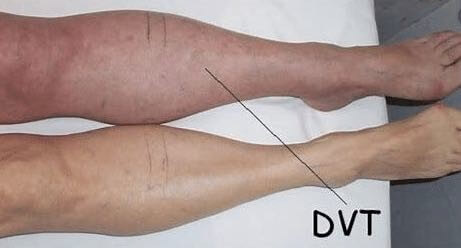
Varicose Veins:
- TYPICAL Symptoms/Presentation:
- Varicosities
- Persistent Oedema
- Venous Ulcerations
- Poor wound healing
- TYPICAL Clinical Signs:
- Vitals:
- Normal
- Other:
- Varicosities, Pedal Oedema, Venous Stasis Ulcers, Eczewma, Haemosiderin Pigmentation,
- Palpation (Hard veins = thrombosis; Tenderness = Thrombophlebitis)
- Special tests (Trendelenburg’s & Perthe’s Tests)
- Vitals:

Lymphangitis:
- TYPICAL Symptoms/Presentation:
- Fever
- Painful, Red, Subcutaneous Streaks
- Painful Lymphadeopathy
- TYPICAL Clinical Signs:
- Vitals:
- Fever, Tachycardia, Tachypnoea
- Other:
- Painful red subcut streaks (inflamed lymphatics), Can ➔ cellulitis
- Vitals:

Giant Cell (Temporal) Arteritis:
- TYPICAL Symptoms/Presentation:
- Fever/Fatigue/Weight Loss
- Headache (Pain on wearing a Hat)
- Jaw Claudication
- Visual Disturbances
- (+/- Polymyalgia Rheumatica – Pain/Stiffness in Neck/Shoulders/Hips)
- TYPICAL Clinical Signs:
- Vitals:
- Fever
- Other:
- Temporal Artery Tenderness
- Cachexia
- Vitals:
Polyarteritis Nodosa:
- TYPICAL Symptoms/Presentation:
- Fever/Rash/Malaise/Weight Loss
- Diffuse Myalgia, Peripheral Neuropathy
- Abdo Pain, Melena
- TYPICAL Clinical Signs:
- Vitals:
- Fever, Hypertension (due to Kidney Failure)
- Other:
- Rash
- Digital Gangrene
- Peripheral Neuropathy
- Vitals:

Buerger’s Disease (Thromboangiitis Obliterans/ “Smoker’s Gangrene”):
- TYPICAL Symptoms/Presentation:
- Peripheral Vascular Insufficiency – Gangrenous Fingertips & Toes/Claudication
- TYPICAL Clinical Signs:
- Vitals:
- Normal (Tachy if recent cigarette), (Tachypnoea if COPD)
- Other:
- Claudication
- Chronic Arterial Ulcers
- Gangrenous Toes/Feet/Fingers
- Signs of Causes:
- ***TAR STAINING FROM SMOKING
- Vitals:
Thank You so Much. Happy Learning!!

